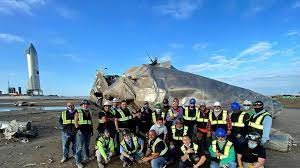A SpaceX inquiry has revealed that hundreds of workers have sustained injuries, including amputations and “crushed limbs,” while attempting to fulfill Elon Musk’s ambition of reaching Mars.
Since 2014, more than 600 injuries have been reported to Reuters through government documents and interviews. Many were severely injured or disabled. They included cuts, fractured bones, crushed hands, and injuries to the skull. Eight accidents resulted in amputations. In 2014 one employee was killed.
At the SpaceX plant in McGregor, Texas, Lonnie LeBlanc was struck by a blast of wind and driven off a trailer, resulting in a fatal head injury.
According to a Reuters investigation, the company has been ignoring standard operating procedures and worker safety rules for years.
Three dozen individuals, including current or former personnel, who are knowledgeable of SpaceX safety procedures were contacted by Reuters. They claim that the workplace’s chaos is reflected in the high injury rates. Staff members who were overworked and ill-prepared frequently disregarded fundamental safety protocols in their haste to fulfill Musk’s ambitious timelines for space missions. SpaceX maintains that employees are in charge of their own safety. More than a dozen current and former workers, including a former senior executive, claim as much.
Is SpaceX Co-Founder to blame?
SpaceX has made major achievements since Musk co-founded the rocket company in 2002, including being the first private enterprise to launch humans into orbit. Currently, it has 13,000 around so workers.
The more than 600 SpaceX injuries that Reuters recorded are but a fraction of the overall number of cases. In 2016, the Occupational Safety and Health Administration (OSHA) of the United States mandated that businesses disclose the overall number of injuries they have had in a given year.
However, Musk himself could appear reckless about safety on visits to company sites.

A report from four staff members, the CEO would occasionally play with an unusual flamethrower that fires a thick flame that is five or ten feet long when he visited a rocket facility in California.
Additionally, he discouraged employees from wearing safety yellow as he dislikes bright colors.
Tom Moline, a former senior avionics engineer at SpaceX who was sacked along with a number of other employees for complaining about their working conditions, said, “Elon’s concept that SpaceX is on this mission to go to Mars as fast as possible and save humanity permeates every part of the company.” “The business justifies ignoring everything that might obstruct achieving that objective, including worker safety.”
In one case, SpaceX paid an OSHA charge of $7,000 for violations that led to a worker’s death. According to OSHA, it has recently increased its monitoring of all businesses.
Eight former SpaceX employees who were familiar with the disaster claim that one serious injury in January 2022 was caused by a series of safety lapses that highlight structural issues at SpaceX.
Francisco Cabada, an employee, suffered a fractured skull and was placed in a coma when a portion of a Raptor V2 rocket engine fell off during pressure testing.

According to Cabada’s spouse, Reuters, the business has disregarded the family’s inquiries about why he wasn’t shielded. “Ydy Cabada expressed that it would have been pleasant to receive a call from Elon Musk.” “But I suppose they just view employees as disposable.”
The Redmond, Washington, location of the corporation had a rate of 0.8, which was identical to the industry average.

Six times higher than the space industry average of 0.8, the 2022 injury rate at the company’s manufacturing and launch plant near Brownsville, Texas, was 4.8 illnesses or injuries per 100 workers.
LeBlanc passed away at the company’s rocket-testing site in McGregor, Texas, where the rate was 2.7 more than three times the average.
At 1.8 injuries per 100 workers, the rate at its production facility in Hawthorne, California, was more than twice as high as the national average.
In 2022, the Kennedy Space Center and Cape Canaveral SpaceX facilities in Florida could not be compared to the industry average. Kennedy withheld injury data for that particular year.
Furthermore, the business classified Cape Canaveral as belonging to a distinct industrial subcategory for which an average rate is not determined by the government.
In 2016, the first year it was obligated to do so, the Kennedy site did publish injury data; but, since then, it has not reported. According to data provided by the facility, the injury rate for that year was 21.5 per 100 workers, which is approximately 27 times higher than the industry average.

At the time, the facility only had 50 employees and had recently taken over a launch pad from the National Aeronautics and Space Administration (NASA) of the United States. According to SpaceX, sixteen of those employees suffered injuries.
Kennedy employed more than 1,100 people by 2021, reports NASA.
NASA reported that, as a private space contractor, it has paid SpaceX $11.8 billion to date. The agency stated that it had the option to enforce contract requirements requiring SpaceX to “have a robust and effective safety program and culture,” but it refrained from commenting on the company’s safety record.
Mission SpaceX
Funded internally, SpaceX created the Falcon 1, their first orbital launch vehicle. An expendable small-lift launch vehicle, the Falcon 1 launched satellites into orbit in two stages. Between $90 million and $100 million was spent on Falcon 1’s development in all.
Inspired by the legendary Millennium Falcon starship from Star Wars, the Falcon rocket series was given its name.
The American spacecraft manufacturer, launch service provider, defense contractor, and satellite communications business Space Exploration Technologies Corp., also known as SpaceX, is based in Hawthorne, California.

With the intention of colonizing Mars and lowering the cost of space travel, Elon Musk started the firm in 2002. Together with the Dragon spacecraft, the business now runs the Falcon 9 and Falcon Heavy rockets.
The business provides internet access using its Starlink constellation of tiny satellites, which as of November 2023 numbered over 5,000 and made history as the largest satellite constellation ever in January 2020.
As the first private corporation, SpaceX is credited for developing the first liquid-propellant rocket to reach orbit, as well as launching, orbiting, and recovering a spacecraft, sending humans to the International Space Station, and sending a spacecraft there.
It is also the first organization of any kind to successfully land an orbital rocket booster vertically and to reuse one of these boosters. Over 200 landings and reflows have been accomplished by the company’s Falcon 9 rockets.











